Global Health Challenge - Assignment
VerifiedAdded on 2022/08/12
|18
|5347
|58
AI Summary
Contribute Materials
Your contribution can guide someone’s learning journey. Share your
documents today.

Running Head: GHC 0
Global health challenge
[Document subtitle]
FEBRUARY 24, 2020
[Company name]
[Company address]
Global health challenge
[Document subtitle]
FEBRUARY 24, 2020
[Company name]
[Company address]
Secure Best Marks with AI Grader
Need help grading? Try our AI Grader for instant feedback on your assignments.
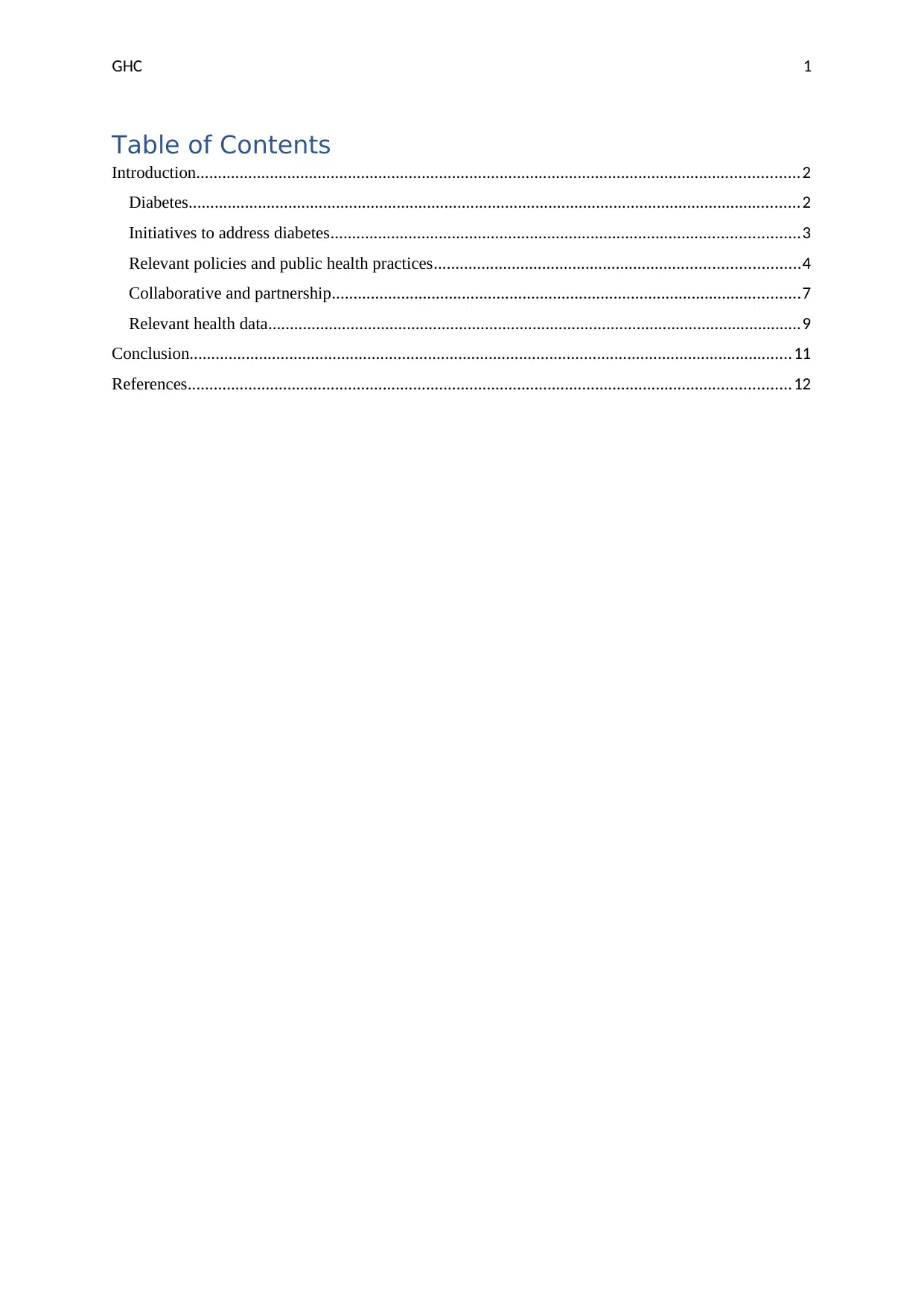
GHC 1
Table of Contents
Introduction...........................................................................................................................................2
Diabetes.............................................................................................................................................2
Initiatives to address diabetes............................................................................................................3
Relevant policies and public health practices....................................................................................4
Collaborative and partnership............................................................................................................7
Relevant health data...........................................................................................................................9
Conclusion...........................................................................................................................................11
References...........................................................................................................................................12
Table of Contents
Introduction...........................................................................................................................................2
Diabetes.............................................................................................................................................2
Initiatives to address diabetes............................................................................................................3
Relevant policies and public health practices....................................................................................4
Collaborative and partnership............................................................................................................7
Relevant health data...........................................................................................................................9
Conclusion...........................................................................................................................................11
References...........................................................................................................................................12
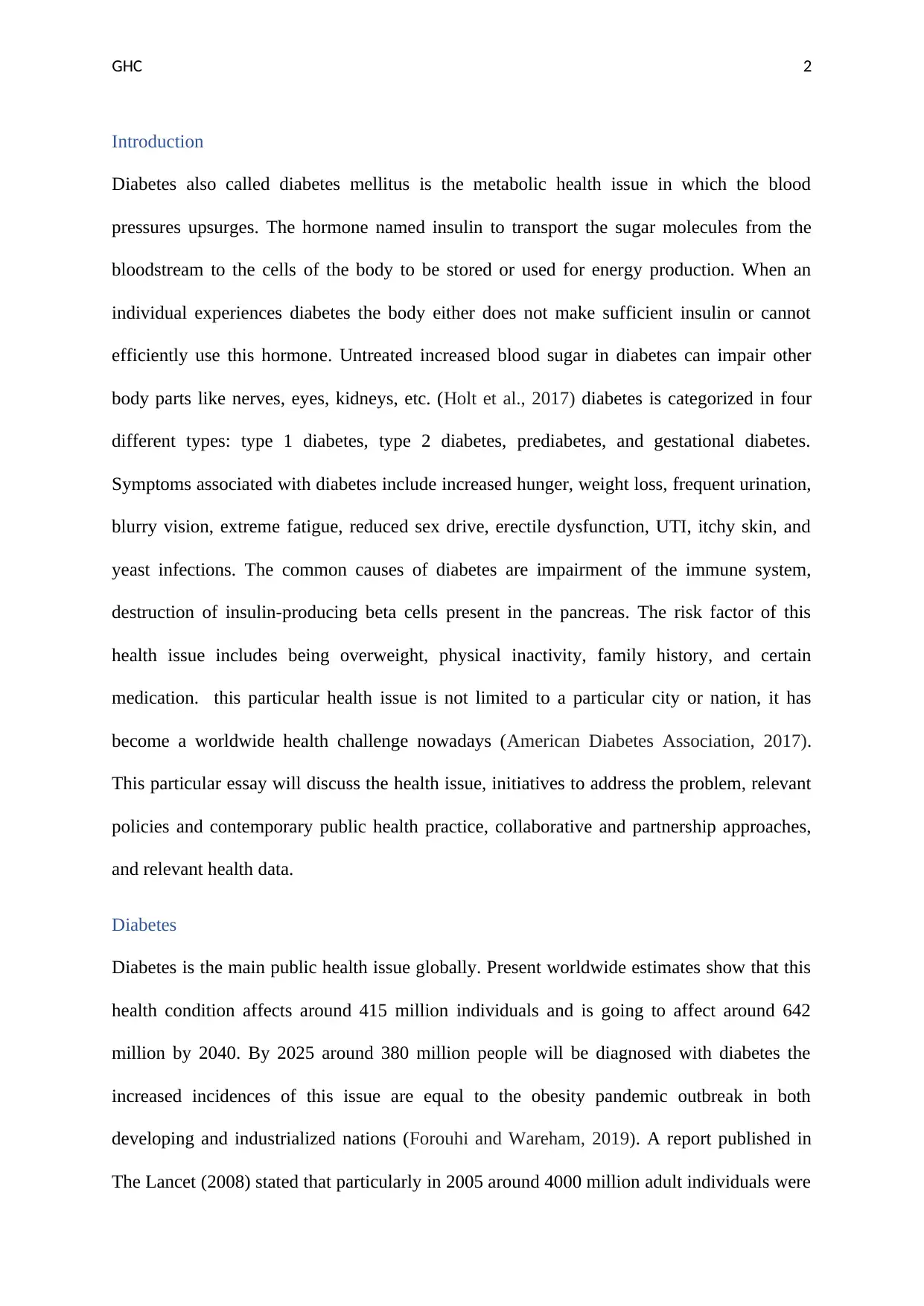
GHC 2
Introduction
Diabetes also called diabetes mellitus is the metabolic health issue in which the blood
pressures upsurges. The hormone named insulin to transport the sugar molecules from the
bloodstream to the cells of the body to be stored or used for energy production. When an
individual experiences diabetes the body either does not make sufficient insulin or cannot
efficiently use this hormone. Untreated increased blood sugar in diabetes can impair other
body parts like nerves, eyes, kidneys, etc. (Holt et al., 2017) diabetes is categorized in four
different types: type 1 diabetes, type 2 diabetes, prediabetes, and gestational diabetes.
Symptoms associated with diabetes include increased hunger, weight loss, frequent urination,
blurry vision, extreme fatigue, reduced sex drive, erectile dysfunction, UTI, itchy skin, and
yeast infections. The common causes of diabetes are impairment of the immune system,
destruction of insulin-producing beta cells present in the pancreas. The risk factor of this
health issue includes being overweight, physical inactivity, family history, and certain
medication. this particular health issue is not limited to a particular city or nation, it has
become a worldwide health challenge nowadays (American Diabetes Association, 2017).
This particular essay will discuss the health issue, initiatives to address the problem, relevant
policies and contemporary public health practice, collaborative and partnership approaches,
and relevant health data.
Diabetes
Diabetes is the main public health issue globally. Present worldwide estimates show that this
health condition affects around 415 million individuals and is going to affect around 642
million by 2040. By 2025 around 380 million people will be diagnosed with diabetes the
increased incidences of this issue are equal to the obesity pandemic outbreak in both
developing and industrialized nations (Forouhi and Wareham, 2019). A report published in
The Lancet (2008) stated that particularly in 2005 around 4000 million adult individuals were
Introduction
Diabetes also called diabetes mellitus is the metabolic health issue in which the blood
pressures upsurges. The hormone named insulin to transport the sugar molecules from the
bloodstream to the cells of the body to be stored or used for energy production. When an
individual experiences diabetes the body either does not make sufficient insulin or cannot
efficiently use this hormone. Untreated increased blood sugar in diabetes can impair other
body parts like nerves, eyes, kidneys, etc. (Holt et al., 2017) diabetes is categorized in four
different types: type 1 diabetes, type 2 diabetes, prediabetes, and gestational diabetes.
Symptoms associated with diabetes include increased hunger, weight loss, frequent urination,
blurry vision, extreme fatigue, reduced sex drive, erectile dysfunction, UTI, itchy skin, and
yeast infections. The common causes of diabetes are impairment of the immune system,
destruction of insulin-producing beta cells present in the pancreas. The risk factor of this
health issue includes being overweight, physical inactivity, family history, and certain
medication. this particular health issue is not limited to a particular city or nation, it has
become a worldwide health challenge nowadays (American Diabetes Association, 2017).
This particular essay will discuss the health issue, initiatives to address the problem, relevant
policies and contemporary public health practice, collaborative and partnership approaches,
and relevant health data.
Diabetes
Diabetes is the main public health issue globally. Present worldwide estimates show that this
health condition affects around 415 million individuals and is going to affect around 642
million by 2040. By 2025 around 380 million people will be diagnosed with diabetes the
increased incidences of this issue are equal to the obesity pandemic outbreak in both
developing and industrialized nations (Forouhi and Wareham, 2019). A report published in
The Lancet (2008) stated that particularly in 2005 around 4000 million adult individuals were
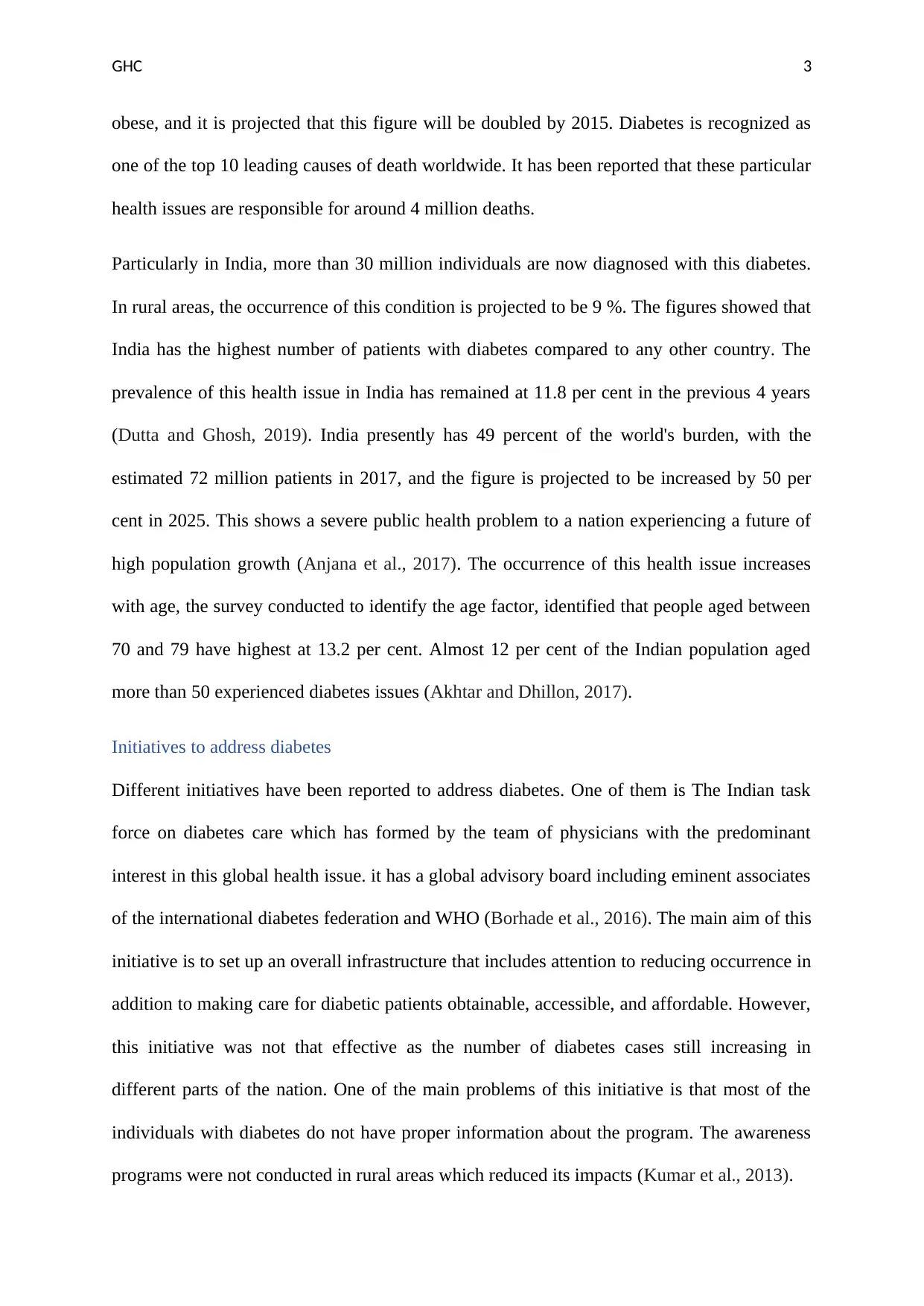
GHC 3
obese, and it is projected that this figure will be doubled by 2015. Diabetes is recognized as
one of the top 10 leading causes of death worldwide. It has been reported that these particular
health issues are responsible for around 4 million deaths.
Particularly in India, more than 30 million individuals are now diagnosed with this diabetes.
In rural areas, the occurrence of this condition is projected to be 9 %. The figures showed that
India has the highest number of patients with diabetes compared to any other country. The
prevalence of this health issue in India has remained at 11.8 per cent in the previous 4 years
(Dutta and Ghosh, 2019). India presently has 49 percent of the world's burden, with the
estimated 72 million patients in 2017, and the figure is projected to be increased by 50 per
cent in 2025. This shows a severe public health problem to a nation experiencing a future of
high population growth (Anjana et al., 2017). The occurrence of this health issue increases
with age, the survey conducted to identify the age factor, identified that people aged between
70 and 79 have highest at 13.2 per cent. Almost 12 per cent of the Indian population aged
more than 50 experienced diabetes issues (Akhtar and Dhillon, 2017).
Initiatives to address diabetes
Different initiatives have been reported to address diabetes. One of them is The Indian task
force on diabetes care which has formed by the team of physicians with the predominant
interest in this global health issue. it has a global advisory board including eminent associates
of the international diabetes federation and WHO (Borhade et al., 2016). The main aim of this
initiative is to set up an overall infrastructure that includes attention to reducing occurrence in
addition to making care for diabetic patients obtainable, accessible, and affordable. However,
this initiative was not that effective as the number of diabetes cases still increasing in
different parts of the nation. One of the main problems of this initiative is that most of the
individuals with diabetes do not have proper information about the program. The awareness
programs were not conducted in rural areas which reduced its impacts (Kumar et al., 2013).
obese, and it is projected that this figure will be doubled by 2015. Diabetes is recognized as
one of the top 10 leading causes of death worldwide. It has been reported that these particular
health issues are responsible for around 4 million deaths.
Particularly in India, more than 30 million individuals are now diagnosed with this diabetes.
In rural areas, the occurrence of this condition is projected to be 9 %. The figures showed that
India has the highest number of patients with diabetes compared to any other country. The
prevalence of this health issue in India has remained at 11.8 per cent in the previous 4 years
(Dutta and Ghosh, 2019). India presently has 49 percent of the world's burden, with the
estimated 72 million patients in 2017, and the figure is projected to be increased by 50 per
cent in 2025. This shows a severe public health problem to a nation experiencing a future of
high population growth (Anjana et al., 2017). The occurrence of this health issue increases
with age, the survey conducted to identify the age factor, identified that people aged between
70 and 79 have highest at 13.2 per cent. Almost 12 per cent of the Indian population aged
more than 50 experienced diabetes issues (Akhtar and Dhillon, 2017).
Initiatives to address diabetes
Different initiatives have been reported to address diabetes. One of them is The Indian task
force on diabetes care which has formed by the team of physicians with the predominant
interest in this global health issue. it has a global advisory board including eminent associates
of the international diabetes federation and WHO (Borhade et al., 2016). The main aim of this
initiative is to set up an overall infrastructure that includes attention to reducing occurrence in
addition to making care for diabetic patients obtainable, accessible, and affordable. However,
this initiative was not that effective as the number of diabetes cases still increasing in
different parts of the nation. One of the main problems of this initiative is that most of the
individuals with diabetes do not have proper information about the program. The awareness
programs were not conducted in rural areas which reduced its impacts (Kumar et al., 2013).
Secure Best Marks with AI Grader
Need help grading? Try our AI Grader for instant feedback on your assignments.

GHC 4
mDiabetes is another initiative for diabetes prevention in Indian states. Health literacy is a
major factor in diabetes occurrence. It has been reported that diabetes issues are affecting
people in both rural and urban areas. people living in rural areas are less aware of the disease
and its prevention strategies. mDiabetes is initiated to increase literacy about the disease and
make people aware of it. mDiabetes is the mobile application can be used to collect
information about the disease and its impact (Muralidharan et al., 2013). It is based upon
mobile communication in India as almost every person now days have a mobile phone, and it
could be a better way to deliver health care services throughout the country. This particular
app was launched by the Ministry of health and family welfare with the help of WHO India
and other associates. mDiabetes helping people to provide information about a healthy diet
and essential active lifestyle which are recognized as the vital approaches to prevent diabetes.
According to Ramachandran et al (2018), the program is feasible and acceptable in the large
population. However, they also suggested that the use of a communicative voice response
system can be an effective way for motivation during the process of registration. Different
other researchers also supported the use of this application and reported that it can further use
to prevent other noncommunicable disorders like hypertension and CVDs. The national
diabetes control program is another initiative of the government of India to tackle the
alarming situation of diabetes in India. It was started in 1987 in some Indian districts such as
Tamil and, Jammu & Kashmir, and Karnataka. However, the program was not expended
further due to a lack of funds (Kumar et al., 2013).
Relevant policies and public health practices
National health policy seeks to ensure access to health care services in a comprehensive
integrated way. It aims to achieve universal health coverage and providing quality care
services to the Indian population at an affordable cost. One of the main goals of this policy is
mDiabetes is another initiative for diabetes prevention in Indian states. Health literacy is a
major factor in diabetes occurrence. It has been reported that diabetes issues are affecting
people in both rural and urban areas. people living in rural areas are less aware of the disease
and its prevention strategies. mDiabetes is initiated to increase literacy about the disease and
make people aware of it. mDiabetes is the mobile application can be used to collect
information about the disease and its impact (Muralidharan et al., 2013). It is based upon
mobile communication in India as almost every person now days have a mobile phone, and it
could be a better way to deliver health care services throughout the country. This particular
app was launched by the Ministry of health and family welfare with the help of WHO India
and other associates. mDiabetes helping people to provide information about a healthy diet
and essential active lifestyle which are recognized as the vital approaches to prevent diabetes.
According to Ramachandran et al (2018), the program is feasible and acceptable in the large
population. However, they also suggested that the use of a communicative voice response
system can be an effective way for motivation during the process of registration. Different
other researchers also supported the use of this application and reported that it can further use
to prevent other noncommunicable disorders like hypertension and CVDs. The national
diabetes control program is another initiative of the government of India to tackle the
alarming situation of diabetes in India. It was started in 1987 in some Indian districts such as
Tamil and, Jammu & Kashmir, and Karnataka. However, the program was not expended
further due to a lack of funds (Kumar et al., 2013).
Relevant policies and public health practices
National health policy seeks to ensure access to health care services in a comprehensive
integrated way. It aims to achieve universal health coverage and providing quality care
services to the Indian population at an affordable cost. One of the main goals of this policy is
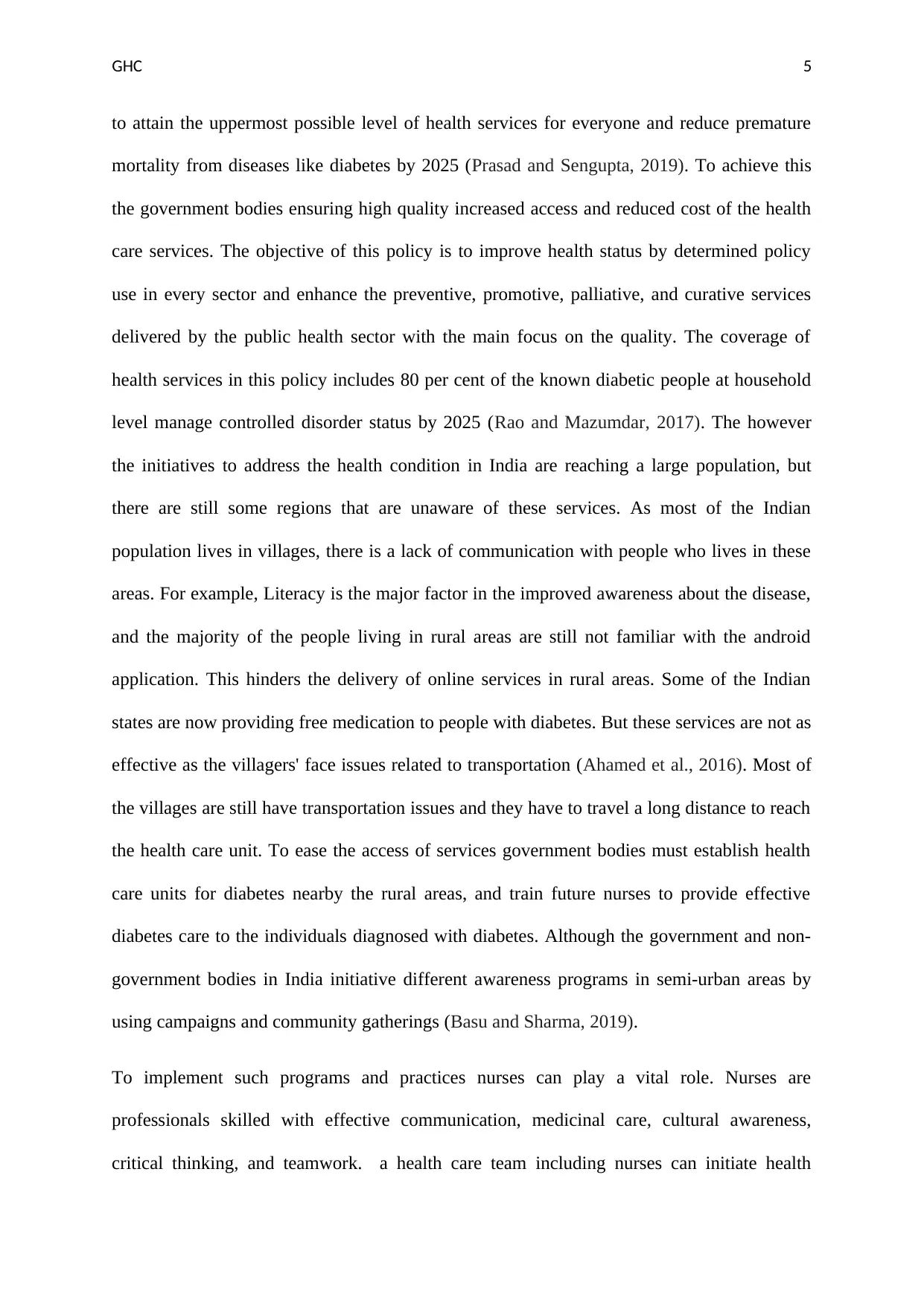
GHC 5
to attain the uppermost possible level of health services for everyone and reduce premature
mortality from diseases like diabetes by 2025 (Prasad and Sengupta, 2019). To achieve this
the government bodies ensuring high quality increased access and reduced cost of the health
care services. The objective of this policy is to improve health status by determined policy
use in every sector and enhance the preventive, promotive, palliative, and curative services
delivered by the public health sector with the main focus on the quality. The coverage of
health services in this policy includes 80 per cent of the known diabetic people at household
level manage controlled disorder status by 2025 (Rao and Mazumdar, 2017). The however
the initiatives to address the health condition in India are reaching a large population, but
there are still some regions that are unaware of these services. As most of the Indian
population lives in villages, there is a lack of communication with people who lives in these
areas. For example, Literacy is the major factor in the improved awareness about the disease,
and the majority of the people living in rural areas are still not familiar with the android
application. This hinders the delivery of online services in rural areas. Some of the Indian
states are now providing free medication to people with diabetes. But these services are not as
effective as the villagers' face issues related to transportation (Ahamed et al., 2016). Most of
the villages are still have transportation issues and they have to travel a long distance to reach
the health care unit. To ease the access of services government bodies must establish health
care units for diabetes nearby the rural areas, and train future nurses to provide effective
diabetes care to the individuals diagnosed with diabetes. Although the government and non-
government bodies in India initiative different awareness programs in semi-urban areas by
using campaigns and community gatherings (Basu and Sharma, 2019).
To implement such programs and practices nurses can play a vital role. Nurses are
professionals skilled with effective communication, medicinal care, cultural awareness,
critical thinking, and teamwork. a health care team including nurses can initiate health
to attain the uppermost possible level of health services for everyone and reduce premature
mortality from diseases like diabetes by 2025 (Prasad and Sengupta, 2019). To achieve this
the government bodies ensuring high quality increased access and reduced cost of the health
care services. The objective of this policy is to improve health status by determined policy
use in every sector and enhance the preventive, promotive, palliative, and curative services
delivered by the public health sector with the main focus on the quality. The coverage of
health services in this policy includes 80 per cent of the known diabetic people at household
level manage controlled disorder status by 2025 (Rao and Mazumdar, 2017). The however
the initiatives to address the health condition in India are reaching a large population, but
there are still some regions that are unaware of these services. As most of the Indian
population lives in villages, there is a lack of communication with people who lives in these
areas. For example, Literacy is the major factor in the improved awareness about the disease,
and the majority of the people living in rural areas are still not familiar with the android
application. This hinders the delivery of online services in rural areas. Some of the Indian
states are now providing free medication to people with diabetes. But these services are not as
effective as the villagers' face issues related to transportation (Ahamed et al., 2016). Most of
the villages are still have transportation issues and they have to travel a long distance to reach
the health care unit. To ease the access of services government bodies must establish health
care units for diabetes nearby the rural areas, and train future nurses to provide effective
diabetes care to the individuals diagnosed with diabetes. Although the government and non-
government bodies in India initiative different awareness programs in semi-urban areas by
using campaigns and community gatherings (Basu and Sharma, 2019).
To implement such programs and practices nurses can play a vital role. Nurses are
professionals skilled with effective communication, medicinal care, cultural awareness,
critical thinking, and teamwork. a health care team including nurses can initiate health
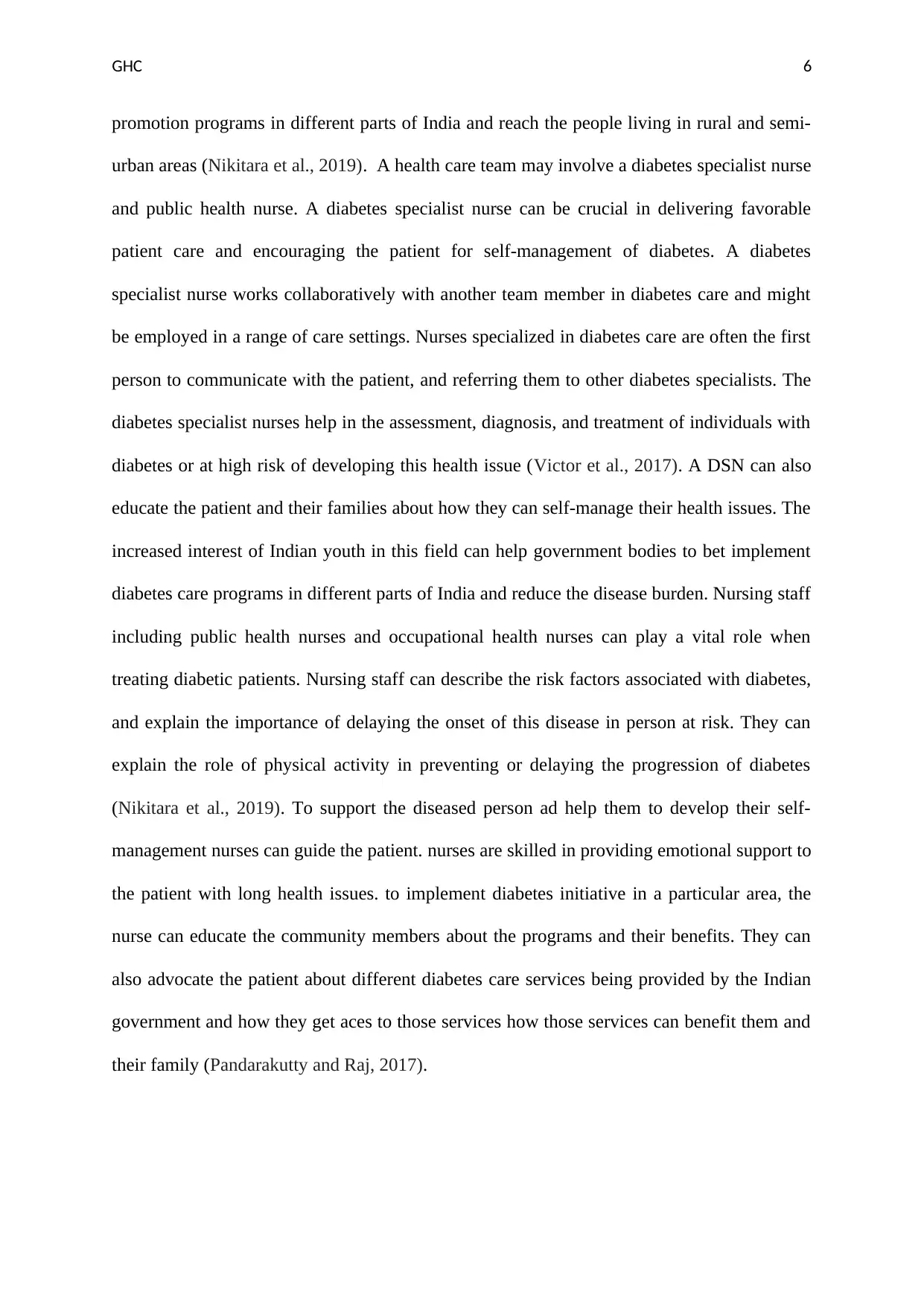
GHC 6
promotion programs in different parts of India and reach the people living in rural and semi-
urban areas (Nikitara et al., 2019). A health care team may involve a diabetes specialist nurse
and public health nurse. A diabetes specialist nurse can be crucial in delivering favorable
patient care and encouraging the patient for self-management of diabetes. A diabetes
specialist nurse works collaboratively with another team member in diabetes care and might
be employed in a range of care settings. Nurses specialized in diabetes care are often the first
person to communicate with the patient, and referring them to other diabetes specialists. The
diabetes specialist nurses help in the assessment, diagnosis, and treatment of individuals with
diabetes or at high risk of developing this health issue (Victor et al., 2017). A DSN can also
educate the patient and their families about how they can self-manage their health issues. The
increased interest of Indian youth in this field can help government bodies to bet implement
diabetes care programs in different parts of India and reduce the disease burden. Nursing staff
including public health nurses and occupational health nurses can play a vital role when
treating diabetic patients. Nursing staff can describe the risk factors associated with diabetes,
and explain the importance of delaying the onset of this disease in person at risk. They can
explain the role of physical activity in preventing or delaying the progression of diabetes
(Nikitara et al., 2019). To support the diseased person ad help them to develop their self-
management nurses can guide the patient. nurses are skilled in providing emotional support to
the patient with long health issues. to implement diabetes initiative in a particular area, the
nurse can educate the community members about the programs and their benefits. They can
also advocate the patient about different diabetes care services being provided by the Indian
government and how they get aces to those services how those services can benefit them and
their family (Pandarakutty and Raj, 2017).
promotion programs in different parts of India and reach the people living in rural and semi-
urban areas (Nikitara et al., 2019). A health care team may involve a diabetes specialist nurse
and public health nurse. A diabetes specialist nurse can be crucial in delivering favorable
patient care and encouraging the patient for self-management of diabetes. A diabetes
specialist nurse works collaboratively with another team member in diabetes care and might
be employed in a range of care settings. Nurses specialized in diabetes care are often the first
person to communicate with the patient, and referring them to other diabetes specialists. The
diabetes specialist nurses help in the assessment, diagnosis, and treatment of individuals with
diabetes or at high risk of developing this health issue (Victor et al., 2017). A DSN can also
educate the patient and their families about how they can self-manage their health issues. The
increased interest of Indian youth in this field can help government bodies to bet implement
diabetes care programs in different parts of India and reduce the disease burden. Nursing staff
including public health nurses and occupational health nurses can play a vital role when
treating diabetic patients. Nursing staff can describe the risk factors associated with diabetes,
and explain the importance of delaying the onset of this disease in person at risk. They can
explain the role of physical activity in preventing or delaying the progression of diabetes
(Nikitara et al., 2019). To support the diseased person ad help them to develop their self-
management nurses can guide the patient. nurses are skilled in providing emotional support to
the patient with long health issues. to implement diabetes initiative in a particular area, the
nurse can educate the community members about the programs and their benefits. They can
also advocate the patient about different diabetes care services being provided by the Indian
government and how they get aces to those services how those services can benefit them and
their family (Pandarakutty and Raj, 2017).
Paraphrase This Document
Need a fresh take? Get an instant paraphrase of this document with our AI Paraphraser
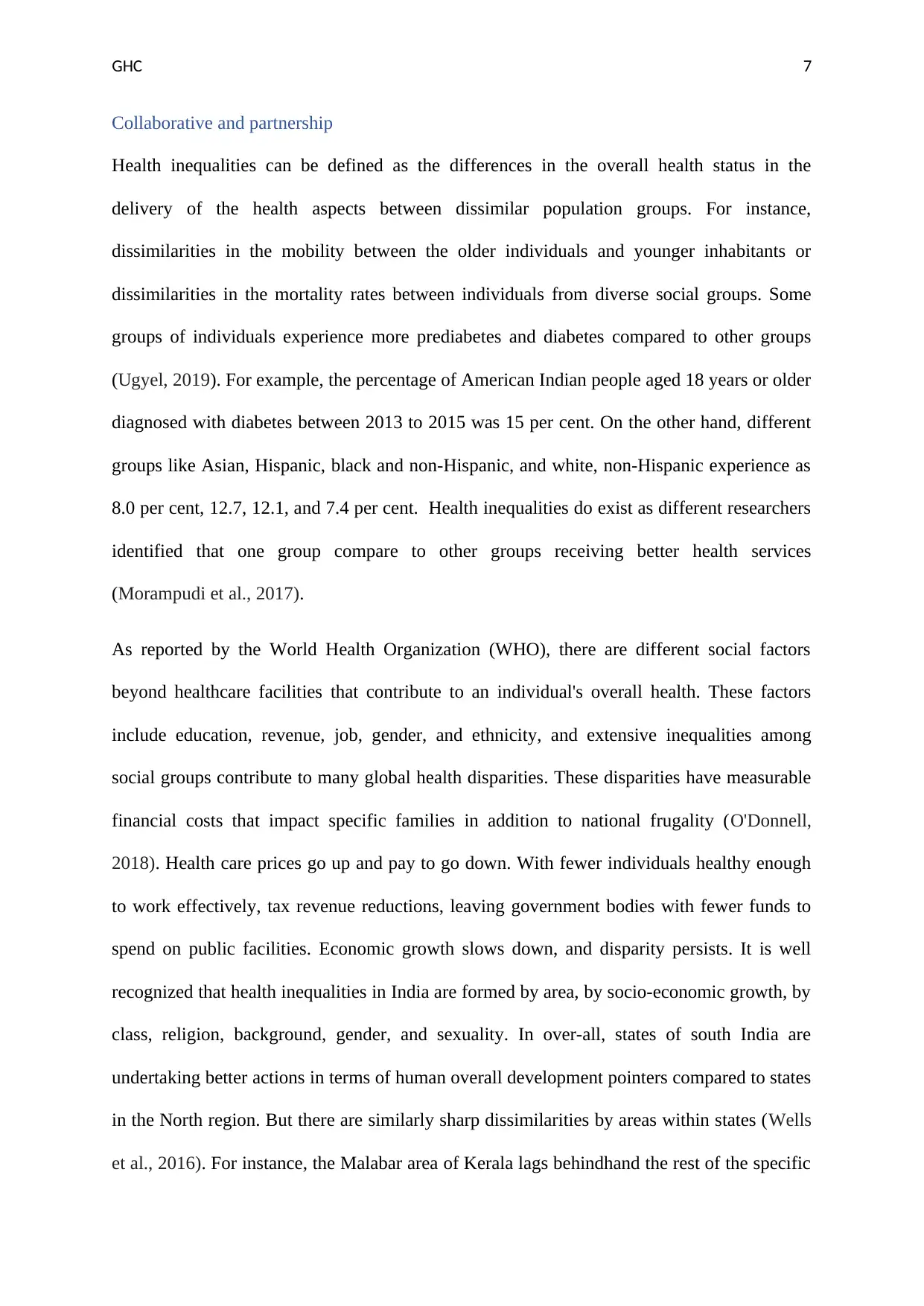
GHC 7
Collaborative and partnership
Health inequalities can be defined as the differences in the overall health status in the
delivery of the health aspects between dissimilar population groups. For instance,
dissimilarities in the mobility between the older individuals and younger inhabitants or
dissimilarities in the mortality rates between individuals from diverse social groups. Some
groups of individuals experience more prediabetes and diabetes compared to other groups
(Ugyel, 2019). For example, the percentage of American Indian people aged 18 years or older
diagnosed with diabetes between 2013 to 2015 was 15 per cent. On the other hand, different
groups like Asian, Hispanic, black and non-Hispanic, and white, non-Hispanic experience as
8.0 per cent, 12.7, 12.1, and 7.4 per cent. Health inequalities do exist as different researchers
identified that one group compare to other groups receiving better health services
(Morampudi et al., 2017).
As reported by the World Health Organization (WHO), there are different social factors
beyond healthcare facilities that contribute to an individual's overall health. These factors
include education, revenue, job, gender, and ethnicity, and extensive inequalities among
social groups contribute to many global health disparities. These disparities have measurable
financial costs that impact specific families in addition to national frugality (O'Donnell,
2018). Health care prices go up and pay to go down. With fewer individuals healthy enough
to work effectively, tax revenue reductions, leaving government bodies with fewer funds to
spend on public facilities. Economic growth slows down, and disparity persists. It is well
recognized that health inequalities in India are formed by area, by socio-economic growth, by
class, religion, background, gender, and sexuality. In over-all, states of south India are
undertaking better actions in terms of human overall development pointers compared to states
in the North region. But there are similarly sharp dissimilarities by areas within states (Wells
et al., 2016). For instance, the Malabar area of Kerala lags behindhand the rest of the specific
Collaborative and partnership
Health inequalities can be defined as the differences in the overall health status in the
delivery of the health aspects between dissimilar population groups. For instance,
dissimilarities in the mobility between the older individuals and younger inhabitants or
dissimilarities in the mortality rates between individuals from diverse social groups. Some
groups of individuals experience more prediabetes and diabetes compared to other groups
(Ugyel, 2019). For example, the percentage of American Indian people aged 18 years or older
diagnosed with diabetes between 2013 to 2015 was 15 per cent. On the other hand, different
groups like Asian, Hispanic, black and non-Hispanic, and white, non-Hispanic experience as
8.0 per cent, 12.7, 12.1, and 7.4 per cent. Health inequalities do exist as different researchers
identified that one group compare to other groups receiving better health services
(Morampudi et al., 2017).
As reported by the World Health Organization (WHO), there are different social factors
beyond healthcare facilities that contribute to an individual's overall health. These factors
include education, revenue, job, gender, and ethnicity, and extensive inequalities among
social groups contribute to many global health disparities. These disparities have measurable
financial costs that impact specific families in addition to national frugality (O'Donnell,
2018). Health care prices go up and pay to go down. With fewer individuals healthy enough
to work effectively, tax revenue reductions, leaving government bodies with fewer funds to
spend on public facilities. Economic growth slows down, and disparity persists. It is well
recognized that health inequalities in India are formed by area, by socio-economic growth, by
class, religion, background, gender, and sexuality. In over-all, states of south India are
undertaking better actions in terms of human overall development pointers compared to states
in the North region. But there are similarly sharp dissimilarities by areas within states (Wells
et al., 2016). For instance, the Malabar area of Kerala lags behindhand the rest of the specific
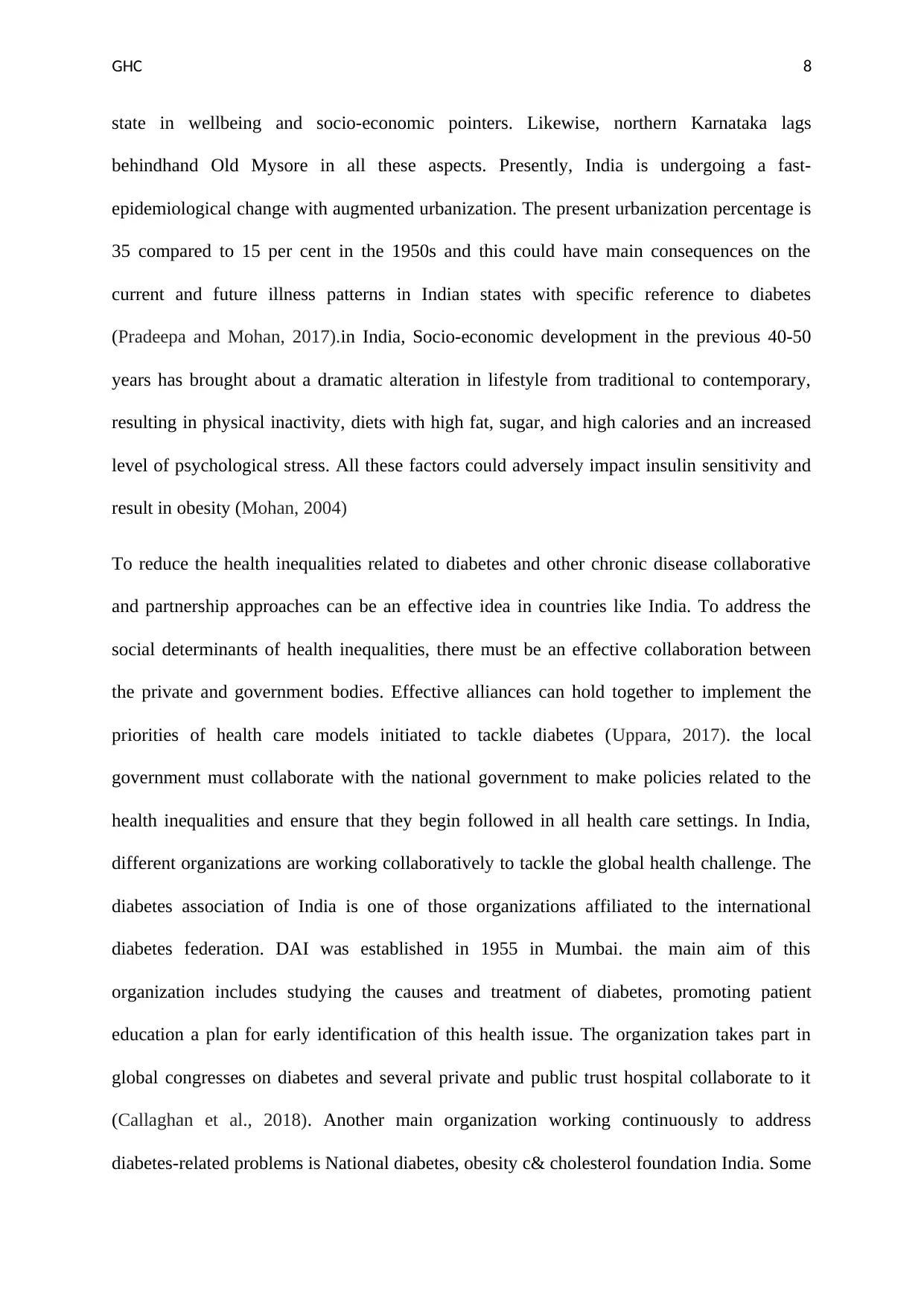
GHC 8
state in wellbeing and socio-economic pointers. Likewise, northern Karnataka lags
behindhand Old Mysore in all these aspects. Presently, India is undergoing a fast-
epidemiological change with augmented urbanization. The present urbanization percentage is
35 compared to 15 per cent in the 1950s and this could have main consequences on the
current and future illness patterns in Indian states with specific reference to diabetes
(Pradeepa and Mohan, 2017).in India, Socio-economic development in the previous 40-50
years has brought about a dramatic alteration in lifestyle from traditional to contemporary,
resulting in physical inactivity, diets with high fat, sugar, and high calories and an increased
level of psychological stress. All these factors could adversely impact insulin sensitivity and
result in obesity (Mohan, 2004)
To reduce the health inequalities related to diabetes and other chronic disease collaborative
and partnership approaches can be an effective idea in countries like India. To address the
social determinants of health inequalities, there must be an effective collaboration between
the private and government bodies. Effective alliances can hold together to implement the
priorities of health care models initiated to tackle diabetes (Uppara, 2017). the local
government must collaborate with the national government to make policies related to the
health inequalities and ensure that they begin followed in all health care settings. In India,
different organizations are working collaboratively to tackle the global health challenge. The
diabetes association of India is one of those organizations affiliated to the international
diabetes federation. DAI was established in 1955 in Mumbai. the main aim of this
organization includes studying the causes and treatment of diabetes, promoting patient
education a plan for early identification of this health issue. The organization takes part in
global congresses on diabetes and several private and public trust hospital collaborate to it
(Callaghan et al., 2018). Another main organization working continuously to address
diabetes-related problems is National diabetes, obesity c& cholesterol foundation India. Some
state in wellbeing and socio-economic pointers. Likewise, northern Karnataka lags
behindhand Old Mysore in all these aspects. Presently, India is undergoing a fast-
epidemiological change with augmented urbanization. The present urbanization percentage is
35 compared to 15 per cent in the 1950s and this could have main consequences on the
current and future illness patterns in Indian states with specific reference to diabetes
(Pradeepa and Mohan, 2017).in India, Socio-economic development in the previous 40-50
years has brought about a dramatic alteration in lifestyle from traditional to contemporary,
resulting in physical inactivity, diets with high fat, sugar, and high calories and an increased
level of psychological stress. All these factors could adversely impact insulin sensitivity and
result in obesity (Mohan, 2004)
To reduce the health inequalities related to diabetes and other chronic disease collaborative
and partnership approaches can be an effective idea in countries like India. To address the
social determinants of health inequalities, there must be an effective collaboration between
the private and government bodies. Effective alliances can hold together to implement the
priorities of health care models initiated to tackle diabetes (Uppara, 2017). the local
government must collaborate with the national government to make policies related to the
health inequalities and ensure that they begin followed in all health care settings. In India,
different organizations are working collaboratively to tackle the global health challenge. The
diabetes association of India is one of those organizations affiliated to the international
diabetes federation. DAI was established in 1955 in Mumbai. the main aim of this
organization includes studying the causes and treatment of diabetes, promoting patient
education a plan for early identification of this health issue. The organization takes part in
global congresses on diabetes and several private and public trust hospital collaborate to it
(Callaghan et al., 2018). Another main organization working continuously to address
diabetes-related problems is National diabetes, obesity c& cholesterol foundation India. Some

GHC 9
of the main goals and objectives of this organization include researching the field of obesity,
and diabetes, link up different foreign institutions and researchers to exchange key ideas and
human resources to educate and investigate treatment. It also helps the government and other
concerned institutions to support education, conduct national programs, and spread awareness
among people to prevent diabetes, obesity, and related issues. it also works in providing
training to doctors, paramedical workers, nurses, nutritionists and psychotherapists for the
management of diabetes and its burden in Indian states (Gopalan and Misra, 2019).
Relevant health data
Particularly In health division, India has made huge strides in the past few decades. The life
expectancy per person has crossed 67 years, baby and under-five death rates are deteriorating
as is the degree of illness incidence. Many illnesses, for example, polio, guinea worm
ailment, yaws, and tetanus, have been eliminated. Regardless of this development,
communicable and non-communicable illnesses are anticipated to endure to remain a core
public health issue in the approaching decades posing a risk to both national and global health
security (Vennu et al., 2019). Besides endemic illnesses for example and HIV/AIDS,
tuberculosis (TB), malaria, and deserted tropical illnesses, the communicable ailment
outbreaks will remain to impacts public health, demanding a high level of willingness in
terms of initial detection and quick response. Disease like diabetes became a major challenge
for the Indian government (Joshi and Aravind, 2017).
While there are numerous health issues that India is battling with, diabetes is one of the most
worrying. The International Diabetes Federation projects that the number of Indians with
diabetes will soar to 123 million by 2040. Currently, 5% of the Indian population suffers
from diabetes. It is a chronic illness where one's body is unable to control its blood glucose
level, which may also lead to heart disease, kidney failure, blindness, amputations, etc.
Adults with diabetes have a two- to three-fold increased risk of heart attacks and strokes
of the main goals and objectives of this organization include researching the field of obesity,
and diabetes, link up different foreign institutions and researchers to exchange key ideas and
human resources to educate and investigate treatment. It also helps the government and other
concerned institutions to support education, conduct national programs, and spread awareness
among people to prevent diabetes, obesity, and related issues. it also works in providing
training to doctors, paramedical workers, nurses, nutritionists and psychotherapists for the
management of diabetes and its burden in Indian states (Gopalan and Misra, 2019).
Relevant health data
Particularly In health division, India has made huge strides in the past few decades. The life
expectancy per person has crossed 67 years, baby and under-five death rates are deteriorating
as is the degree of illness incidence. Many illnesses, for example, polio, guinea worm
ailment, yaws, and tetanus, have been eliminated. Regardless of this development,
communicable and non-communicable illnesses are anticipated to endure to remain a core
public health issue in the approaching decades posing a risk to both national and global health
security (Vennu et al., 2019). Besides endemic illnesses for example and HIV/AIDS,
tuberculosis (TB), malaria, and deserted tropical illnesses, the communicable ailment
outbreaks will remain to impacts public health, demanding a high level of willingness in
terms of initial detection and quick response. Disease like diabetes became a major challenge
for the Indian government (Joshi and Aravind, 2017).
While there are numerous health issues that India is battling with, diabetes is one of the most
worrying. The International Diabetes Federation projects that the number of Indians with
diabetes will soar to 123 million by 2040. Currently, 5% of the Indian population suffers
from diabetes. It is a chronic illness where one's body is unable to control its blood glucose
level, which may also lead to heart disease, kidney failure, blindness, amputations, etc.
Adults with diabetes have a two- to three-fold increased risk of heart attacks and strokes
Secure Best Marks with AI Grader
Need help grading? Try our AI Grader for instant feedback on your assignments.
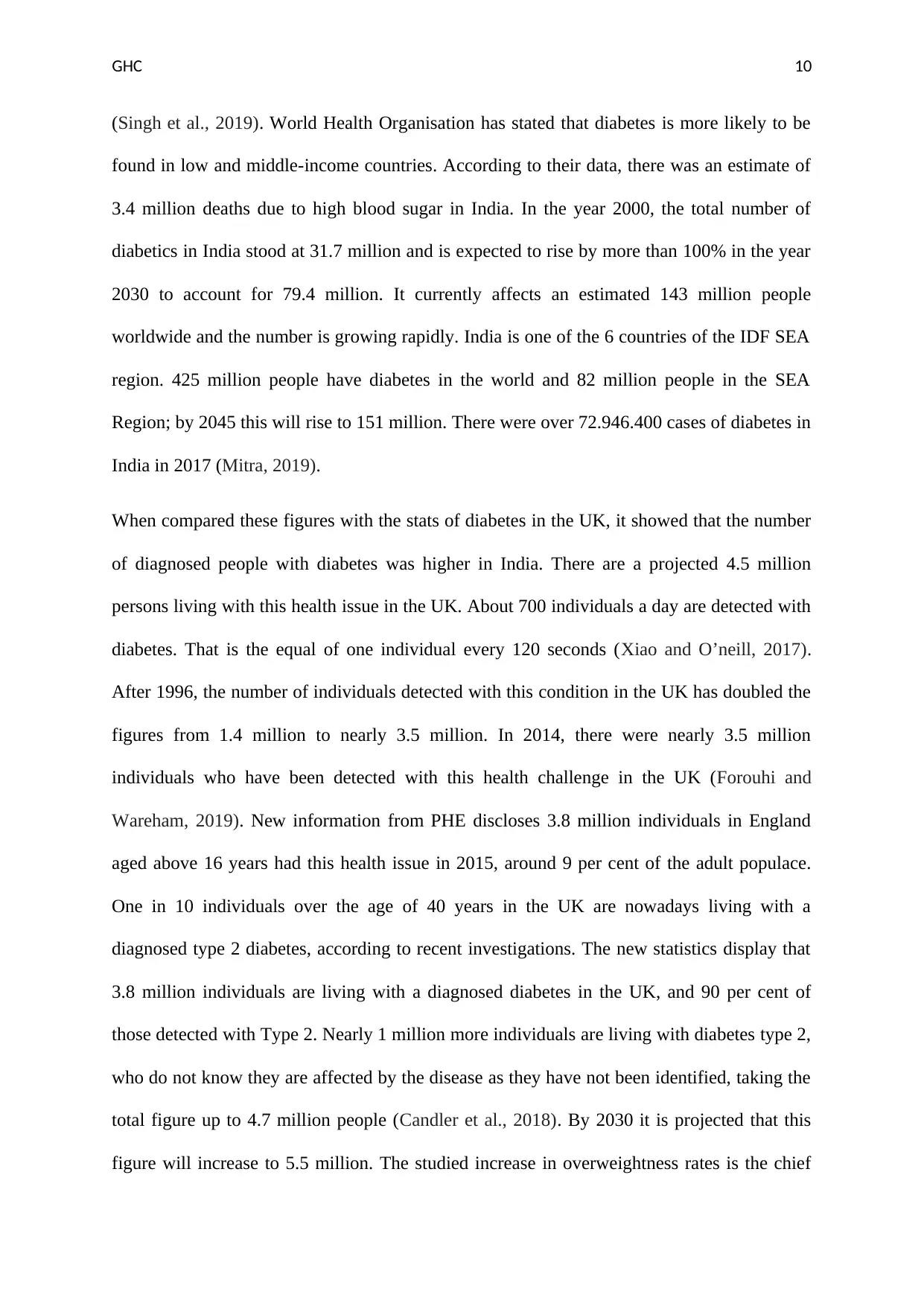
GHC 10
(Singh et al., 2019). World Health Organisation has stated that diabetes is more likely to be
found in low and middle-income countries. According to their data, there was an estimate of
3.4 million deaths due to high blood sugar in India. In the year 2000, the total number of
diabetics in India stood at 31.7 million and is expected to rise by more than 100% in the year
2030 to account for 79.4 million. It currently affects an estimated 143 million people
worldwide and the number is growing rapidly. India is one of the 6 countries of the IDF SEA
region. 425 million people have diabetes in the world and 82 million people in the SEA
Region; by 2045 this will rise to 151 million. There were over 72.946.400 cases of diabetes in
India in 2017 (Mitra, 2019).
When compared these figures with the stats of diabetes in the UK, it showed that the number
of diagnosed people with diabetes was higher in India. There are a projected 4.5 million
persons living with this health issue in the UK. About 700 individuals a day are detected with
diabetes. That is the equal of one individual every 120 seconds (Xiao and O’neill, 2017).
After 1996, the number of individuals detected with this condition in the UK has doubled the
figures from 1.4 million to nearly 3.5 million. In 2014, there were nearly 3.5 million
individuals who have been detected with this health challenge in the UK (Forouhi and
Wareham, 2019). New information from PHE discloses 3.8 million individuals in England
aged above 16 years had this health issue in 2015, around 9 per cent of the adult populace.
One in 10 individuals over the age of 40 years in the UK are nowadays living with a
diagnosed type 2 diabetes, according to recent investigations. The new statistics display that
3.8 million individuals are living with a diagnosed diabetes in the UK, and 90 per cent of
those detected with Type 2. Nearly 1 million more individuals are living with diabetes type 2,
who do not know they are affected by the disease as they have not been identified, taking the
total figure up to 4.7 million people (Candler et al., 2018). By 2030 it is projected that this
figure will increase to 5.5 million. The studied increase in overweightness rates is the chief
(Singh et al., 2019). World Health Organisation has stated that diabetes is more likely to be
found in low and middle-income countries. According to their data, there was an estimate of
3.4 million deaths due to high blood sugar in India. In the year 2000, the total number of
diabetics in India stood at 31.7 million and is expected to rise by more than 100% in the year
2030 to account for 79.4 million. It currently affects an estimated 143 million people
worldwide and the number is growing rapidly. India is one of the 6 countries of the IDF SEA
region. 425 million people have diabetes in the world and 82 million people in the SEA
Region; by 2045 this will rise to 151 million. There were over 72.946.400 cases of diabetes in
India in 2017 (Mitra, 2019).
When compared these figures with the stats of diabetes in the UK, it showed that the number
of diagnosed people with diabetes was higher in India. There are a projected 4.5 million
persons living with this health issue in the UK. About 700 individuals a day are detected with
diabetes. That is the equal of one individual every 120 seconds (Xiao and O’neill, 2017).
After 1996, the number of individuals detected with this condition in the UK has doubled the
figures from 1.4 million to nearly 3.5 million. In 2014, there were nearly 3.5 million
individuals who have been detected with this health challenge in the UK (Forouhi and
Wareham, 2019). New information from PHE discloses 3.8 million individuals in England
aged above 16 years had this health issue in 2015, around 9 per cent of the adult populace.
One in 10 individuals over the age of 40 years in the UK are nowadays living with a
diagnosed type 2 diabetes, according to recent investigations. The new statistics display that
3.8 million individuals are living with a diagnosed diabetes in the UK, and 90 per cent of
those detected with Type 2. Nearly 1 million more individuals are living with diabetes type 2,
who do not know they are affected by the disease as they have not been identified, taking the
total figure up to 4.7 million people (Candler et al., 2018). By 2030 it is projected that this
figure will increase to 5.5 million. The studied increase in overweightness rates is the chief
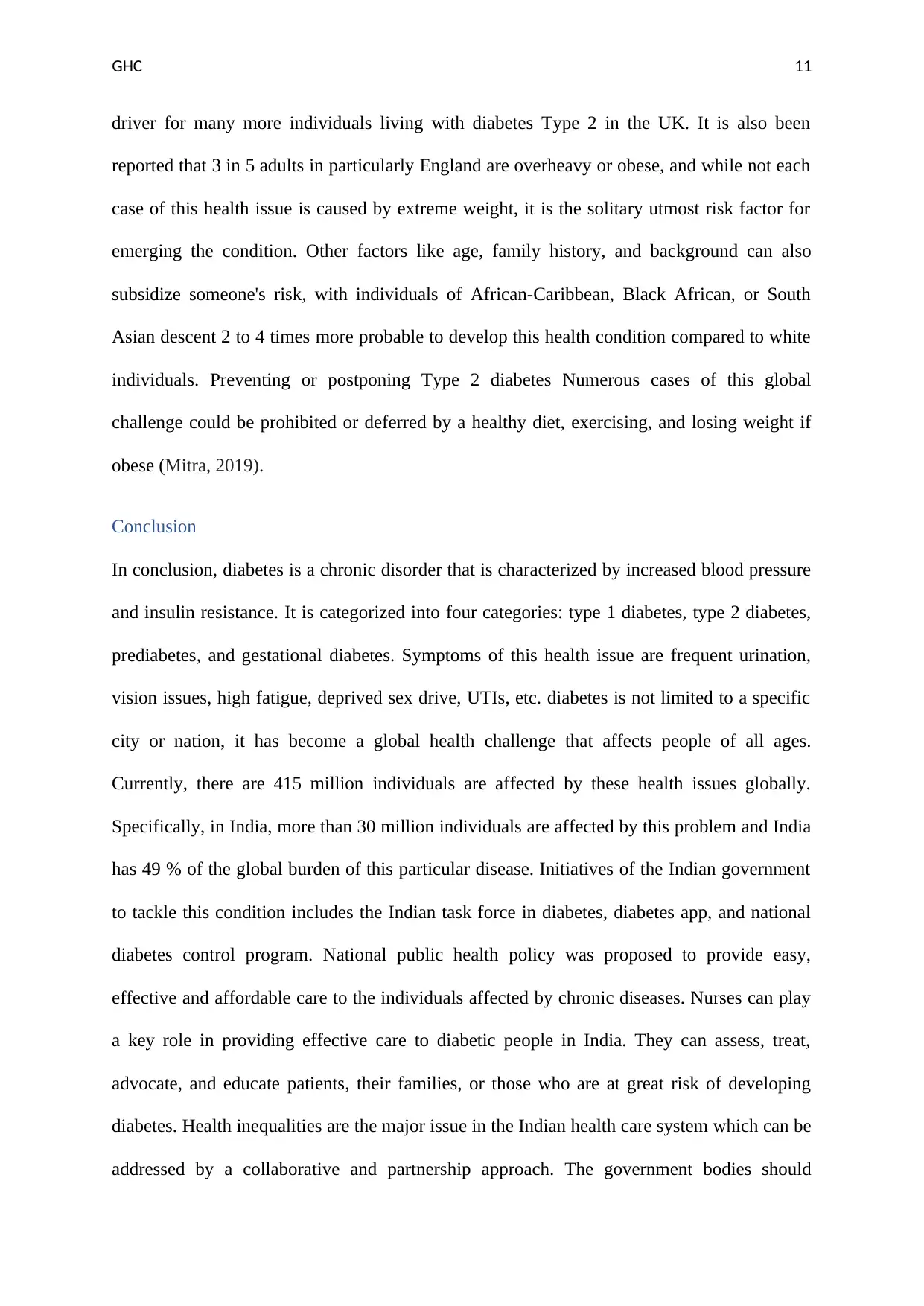
GHC 11
driver for many more individuals living with diabetes Type 2 in the UK. It is also been
reported that 3 in 5 adults in particularly England are overheavy or obese, and while not each
case of this health issue is caused by extreme weight, it is the solitary utmost risk factor for
emerging the condition. Other factors like age, family history, and background can also
subsidize someone's risk, with individuals of African-Caribbean, Black African, or South
Asian descent 2 to 4 times more probable to develop this health condition compared to white
individuals. Preventing or postponing Type 2 diabetes Numerous cases of this global
challenge could be prohibited or deferred by a healthy diet, exercising, and losing weight if
obese (Mitra, 2019).
Conclusion
In conclusion, diabetes is a chronic disorder that is characterized by increased blood pressure
and insulin resistance. It is categorized into four categories: type 1 diabetes, type 2 diabetes,
prediabetes, and gestational diabetes. Symptoms of this health issue are frequent urination,
vision issues, high fatigue, deprived sex drive, UTIs, etc. diabetes is not limited to a specific
city or nation, it has become a global health challenge that affects people of all ages.
Currently, there are 415 million individuals are affected by these health issues globally.
Specifically, in India, more than 30 million individuals are affected by this problem and India
has 49 % of the global burden of this particular disease. Initiatives of the Indian government
to tackle this condition includes the Indian task force in diabetes, diabetes app, and national
diabetes control program. National public health policy was proposed to provide easy,
effective and affordable care to the individuals affected by chronic diseases. Nurses can play
a key role in providing effective care to diabetic people in India. They can assess, treat,
advocate, and educate patients, their families, or those who are at great risk of developing
diabetes. Health inequalities are the major issue in the Indian health care system which can be
addressed by a collaborative and partnership approach. The government bodies should
driver for many more individuals living with diabetes Type 2 in the UK. It is also been
reported that 3 in 5 adults in particularly England are overheavy or obese, and while not each
case of this health issue is caused by extreme weight, it is the solitary utmost risk factor for
emerging the condition. Other factors like age, family history, and background can also
subsidize someone's risk, with individuals of African-Caribbean, Black African, or South
Asian descent 2 to 4 times more probable to develop this health condition compared to white
individuals. Preventing or postponing Type 2 diabetes Numerous cases of this global
challenge could be prohibited or deferred by a healthy diet, exercising, and losing weight if
obese (Mitra, 2019).
Conclusion
In conclusion, diabetes is a chronic disorder that is characterized by increased blood pressure
and insulin resistance. It is categorized into four categories: type 1 diabetes, type 2 diabetes,
prediabetes, and gestational diabetes. Symptoms of this health issue are frequent urination,
vision issues, high fatigue, deprived sex drive, UTIs, etc. diabetes is not limited to a specific
city or nation, it has become a global health challenge that affects people of all ages.
Currently, there are 415 million individuals are affected by these health issues globally.
Specifically, in India, more than 30 million individuals are affected by this problem and India
has 49 % of the global burden of this particular disease. Initiatives of the Indian government
to tackle this condition includes the Indian task force in diabetes, diabetes app, and national
diabetes control program. National public health policy was proposed to provide easy,
effective and affordable care to the individuals affected by chronic diseases. Nurses can play
a key role in providing effective care to diabetic people in India. They can assess, treat,
advocate, and educate patients, their families, or those who are at great risk of developing
diabetes. Health inequalities are the major issue in the Indian health care system which can be
addressed by a collaborative and partnership approach. The government bodies should
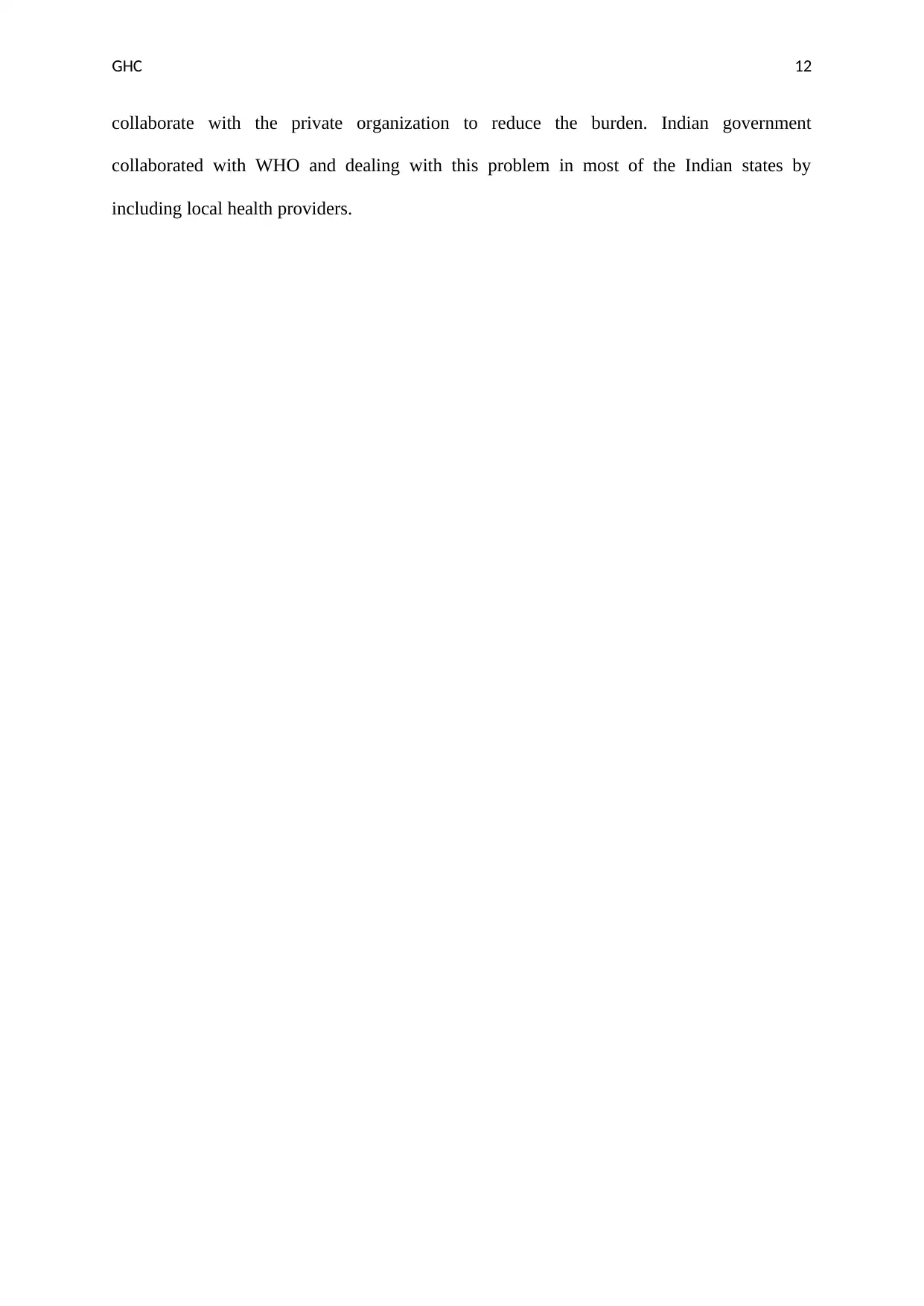
GHC 12
collaborate with the private organization to reduce the burden. Indian government
collaborated with WHO and dealing with this problem in most of the Indian states by
including local health providers.
collaborate with the private organization to reduce the burden. Indian government
collaborated with WHO and dealing with this problem in most of the Indian states by
including local health providers.
Paraphrase This Document
Need a fresh take? Get an instant paraphrase of this document with our AI Paraphraser
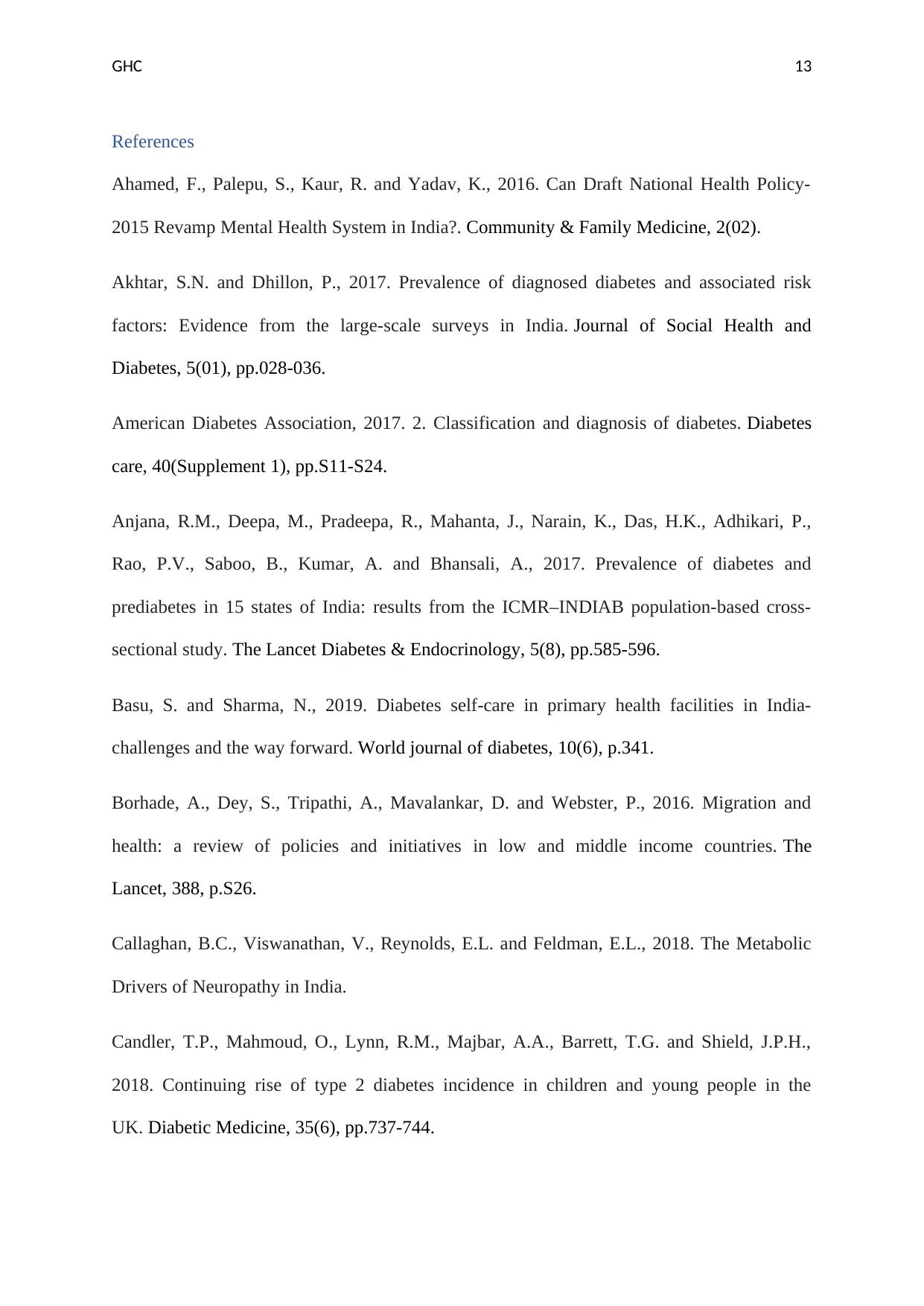
GHC 13
References
Ahamed, F., Palepu, S., Kaur, R. and Yadav, K., 2016. Can Draft National Health Policy-
2015 Revamp Mental Health System in India?. Community & Family Medicine, 2(02).
Akhtar, S.N. and Dhillon, P., 2017. Prevalence of diagnosed diabetes and associated risk
factors: Evidence from the large-scale surveys in India. Journal of Social Health and
Diabetes, 5(01), pp.028-036.
American Diabetes Association, 2017. 2. Classification and diagnosis of diabetes. Diabetes
care, 40(Supplement 1), pp.S11-S24.
Anjana, R.M., Deepa, M., Pradeepa, R., Mahanta, J., Narain, K., Das, H.K., Adhikari, P.,
Rao, P.V., Saboo, B., Kumar, A. and Bhansali, A., 2017. Prevalence of diabetes and
prediabetes in 15 states of India: results from the ICMR–INDIAB population-based cross-
sectional study. The Lancet Diabetes & Endocrinology, 5(8), pp.585-596.
Basu, S. and Sharma, N., 2019. Diabetes self-care in primary health facilities in India-
challenges and the way forward. World journal of diabetes, 10(6), p.341.
Borhade, A., Dey, S., Tripathi, A., Mavalankar, D. and Webster, P., 2016. Migration and
health: a review of policies and initiatives in low and middle income countries. The
Lancet, 388, p.S26.
Callaghan, B.C., Viswanathan, V., Reynolds, E.L. and Feldman, E.L., 2018. The Metabolic
Drivers of Neuropathy in India.
Candler, T.P., Mahmoud, O., Lynn, R.M., Majbar, A.A., Barrett, T.G. and Shield, J.P.H.,
2018. Continuing rise of type 2 diabetes incidence in children and young people in the
UK. Diabetic Medicine, 35(6), pp.737-744.
References
Ahamed, F., Palepu, S., Kaur, R. and Yadav, K., 2016. Can Draft National Health Policy-
2015 Revamp Mental Health System in India?. Community & Family Medicine, 2(02).
Akhtar, S.N. and Dhillon, P., 2017. Prevalence of diagnosed diabetes and associated risk
factors: Evidence from the large-scale surveys in India. Journal of Social Health and
Diabetes, 5(01), pp.028-036.
American Diabetes Association, 2017. 2. Classification and diagnosis of diabetes. Diabetes
care, 40(Supplement 1), pp.S11-S24.
Anjana, R.M., Deepa, M., Pradeepa, R., Mahanta, J., Narain, K., Das, H.K., Adhikari, P.,
Rao, P.V., Saboo, B., Kumar, A. and Bhansali, A., 2017. Prevalence of diabetes and
prediabetes in 15 states of India: results from the ICMR–INDIAB population-based cross-
sectional study. The Lancet Diabetes & Endocrinology, 5(8), pp.585-596.
Basu, S. and Sharma, N., 2019. Diabetes self-care in primary health facilities in India-
challenges and the way forward. World journal of diabetes, 10(6), p.341.
Borhade, A., Dey, S., Tripathi, A., Mavalankar, D. and Webster, P., 2016. Migration and
health: a review of policies and initiatives in low and middle income countries. The
Lancet, 388, p.S26.
Callaghan, B.C., Viswanathan, V., Reynolds, E.L. and Feldman, E.L., 2018. The Metabolic
Drivers of Neuropathy in India.
Candler, T.P., Mahmoud, O., Lynn, R.M., Majbar, A.A., Barrett, T.G. and Shield, J.P.H.,
2018. Continuing rise of type 2 diabetes incidence in children and young people in the
UK. Diabetic Medicine, 35(6), pp.737-744.
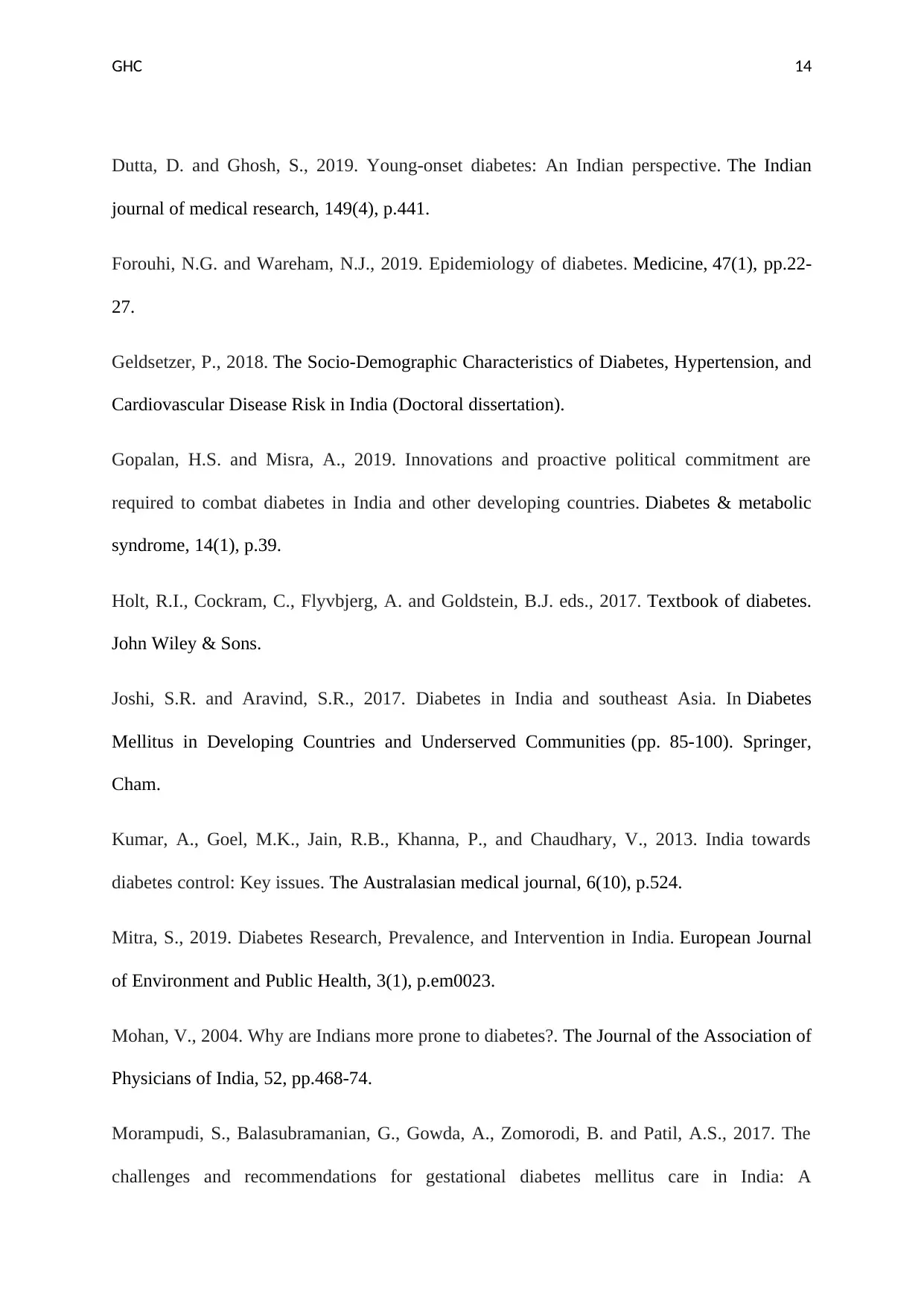
GHC 14
Dutta, D. and Ghosh, S., 2019. Young-onset diabetes: An Indian perspective. The Indian
journal of medical research, 149(4), p.441.
Forouhi, N.G. and Wareham, N.J., 2019. Epidemiology of diabetes. Medicine, 47(1), pp.22-
27.
Geldsetzer, P., 2018. The Socio-Demographic Characteristics of Diabetes, Hypertension, and
Cardiovascular Disease Risk in India (Doctoral dissertation).
Gopalan, H.S. and Misra, A., 2019. Innovations and proactive political commitment are
required to combat diabetes in India and other developing countries. Diabetes & metabolic
syndrome, 14(1), p.39.
Holt, R.I., Cockram, C., Flyvbjerg, A. and Goldstein, B.J. eds., 2017. Textbook of diabetes.
John Wiley & Sons.
Joshi, S.R. and Aravind, S.R., 2017. Diabetes in India and southeast Asia. In Diabetes
Mellitus in Developing Countries and Underserved Communities (pp. 85-100). Springer,
Cham.
Kumar, A., Goel, M.K., Jain, R.B., Khanna, P., and Chaudhary, V., 2013. India towards
diabetes control: Key issues. The Australasian medical journal, 6(10), p.524.
Mitra, S., 2019. Diabetes Research, Prevalence, and Intervention in India. European Journal
of Environment and Public Health, 3(1), p.em0023.
Mohan, V., 2004. Why are Indians more prone to diabetes?. The Journal of the Association of
Physicians of India, 52, pp.468-74.
Morampudi, S., Balasubramanian, G., Gowda, A., Zomorodi, B. and Patil, A.S., 2017. The
challenges and recommendations for gestational diabetes mellitus care in India: A
Dutta, D. and Ghosh, S., 2019. Young-onset diabetes: An Indian perspective. The Indian
journal of medical research, 149(4), p.441.
Forouhi, N.G. and Wareham, N.J., 2019. Epidemiology of diabetes. Medicine, 47(1), pp.22-
27.
Geldsetzer, P., 2018. The Socio-Demographic Characteristics of Diabetes, Hypertension, and
Cardiovascular Disease Risk in India (Doctoral dissertation).
Gopalan, H.S. and Misra, A., 2019. Innovations and proactive political commitment are
required to combat diabetes in India and other developing countries. Diabetes & metabolic
syndrome, 14(1), p.39.
Holt, R.I., Cockram, C., Flyvbjerg, A. and Goldstein, B.J. eds., 2017. Textbook of diabetes.
John Wiley & Sons.
Joshi, S.R. and Aravind, S.R., 2017. Diabetes in India and southeast Asia. In Diabetes
Mellitus in Developing Countries and Underserved Communities (pp. 85-100). Springer,
Cham.
Kumar, A., Goel, M.K., Jain, R.B., Khanna, P., and Chaudhary, V., 2013. India towards
diabetes control: Key issues. The Australasian medical journal, 6(10), p.524.
Mitra, S., 2019. Diabetes Research, Prevalence, and Intervention in India. European Journal
of Environment and Public Health, 3(1), p.em0023.
Mohan, V., 2004. Why are Indians more prone to diabetes?. The Journal of the Association of
Physicians of India, 52, pp.468-74.
Morampudi, S., Balasubramanian, G., Gowda, A., Zomorodi, B. and Patil, A.S., 2017. The
challenges and recommendations for gestational diabetes mellitus care in India: A

GHC 15
Review. Frontiers in endocrinology, 8, p.56.
Muralidharan, S., Mohan, V., Anjana, R.M., Jena, S., Tandon, N., Allender, S. and Ranjani,
H., 2017. Mobile health technology (mDiab) for the prevention of type 2 diabetes: protocol
for a randomized controlled trial. JMIR research protocols, 6(12), p.e242.
Nikitara, M., Constantinou, C.S., Andreou, E. and Diomidous, M., 2019. The Role of Nurses
and the Facilitators and Barriers in Diabetes Care: A Mixed Methods Systematic Literature
Review. Behavioral Sciences, 9(6), p.61.
O'Donnell, S., 2018. Fundamental causes of inequalities in diabetes management outcomes: a
qualitative analysis. European Journal of Public Health, 28(suppl_4), pp.cky214-152.
Pandarakutty, S. and Raj, K., 2017. Role of Nurse in Prevention and Care of Diabetic Foot
Complications. International Journal of Nursing Care, 5(2), pp.46-50.
Pradeepa, R. and Mohan, V., 2017. Prevalence of type 2 diabetes and its complications in
India and economic costs to the nation. European journal of clinical nutrition, 71(7), pp.816-
824.
Prasad, V. and Sengupta, A., 2019. Perpetuating health inequities in India: global ethics in
policy and practice. Journal of Global Ethics, 15(1), pp.67-75.
Ramachandran, A., Kumar, R., Nanditha, A., Raghavan, A., Snehalatha, C., Krishnamoorthy,
S., Joshi, P. and Tesfaye, F., 2018. mDiabetes initiative using text messages to improve
lifestyle and health-seeking behaviour in India. BMJ Innovations, 4(4), pp.155-162.
Rao, M. and Mazumdar, V., 2017. Statement on national health policy. In The Lineaments of
Population Policy in India (pp. 489-501). Routledge India.
Review. Frontiers in endocrinology, 8, p.56.
Muralidharan, S., Mohan, V., Anjana, R.M., Jena, S., Tandon, N., Allender, S. and Ranjani,
H., 2017. Mobile health technology (mDiab) for the prevention of type 2 diabetes: protocol
for a randomized controlled trial. JMIR research protocols, 6(12), p.e242.
Nikitara, M., Constantinou, C.S., Andreou, E. and Diomidous, M., 2019. The Role of Nurses
and the Facilitators and Barriers in Diabetes Care: A Mixed Methods Systematic Literature
Review. Behavioral Sciences, 9(6), p.61.
O'Donnell, S., 2018. Fundamental causes of inequalities in diabetes management outcomes: a
qualitative analysis. European Journal of Public Health, 28(suppl_4), pp.cky214-152.
Pandarakutty, S. and Raj, K., 2017. Role of Nurse in Prevention and Care of Diabetic Foot
Complications. International Journal of Nursing Care, 5(2), pp.46-50.
Pradeepa, R. and Mohan, V., 2017. Prevalence of type 2 diabetes and its complications in
India and economic costs to the nation. European journal of clinical nutrition, 71(7), pp.816-
824.
Prasad, V. and Sengupta, A., 2019. Perpetuating health inequities in India: global ethics in
policy and practice. Journal of Global Ethics, 15(1), pp.67-75.
Ramachandran, A., Kumar, R., Nanditha, A., Raghavan, A., Snehalatha, C., Krishnamoorthy,
S., Joshi, P. and Tesfaye, F., 2018. mDiabetes initiative using text messages to improve
lifestyle and health-seeking behaviour in India. BMJ Innovations, 4(4), pp.155-162.
Rao, M. and Mazumdar, V., 2017. Statement on national health policy. In The Lineaments of
Population Policy in India (pp. 489-501). Routledge India.
Secure Best Marks with AI Grader
Need help grading? Try our AI Grader for instant feedback on your assignments.
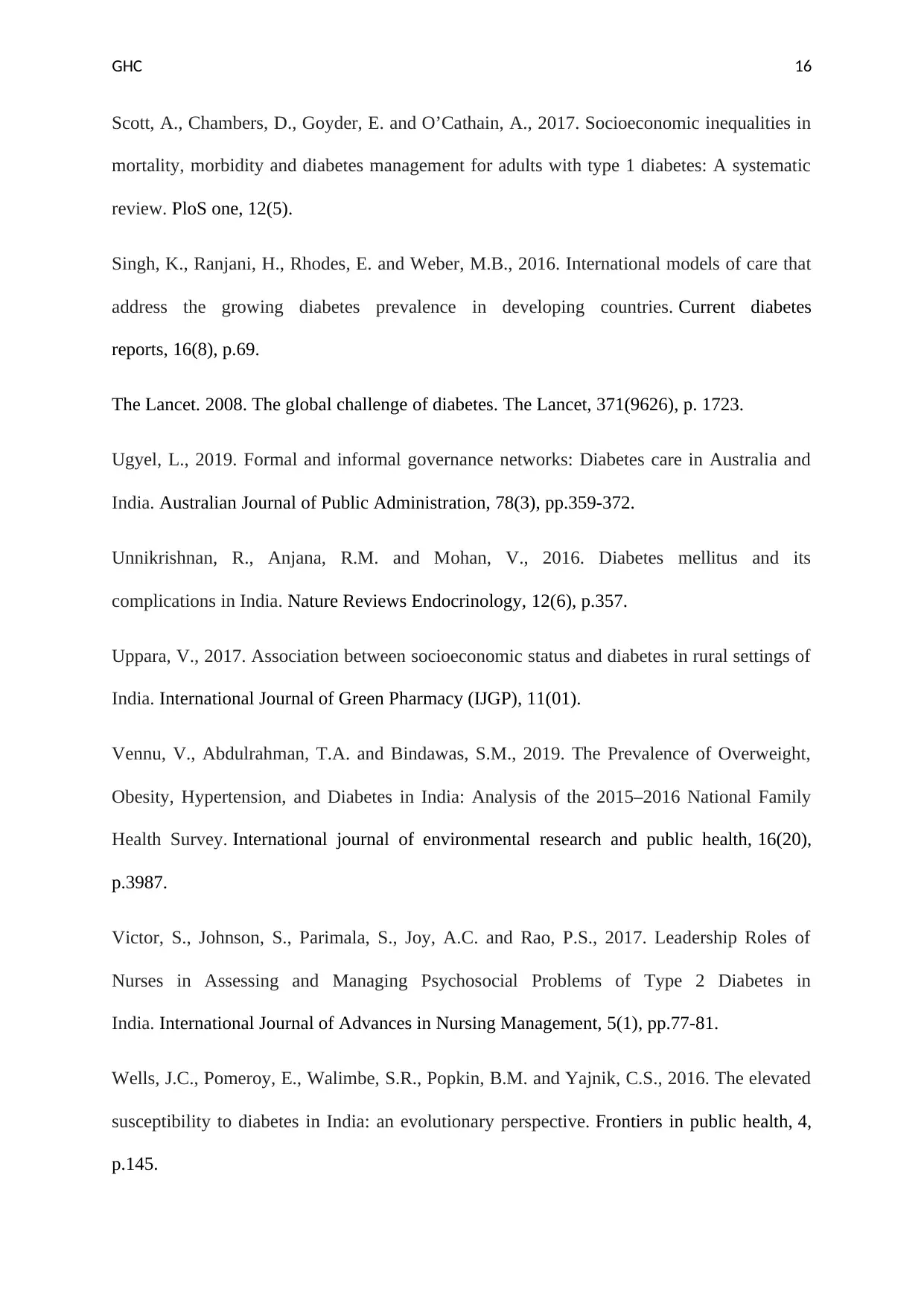
GHC 16
Scott, A., Chambers, D., Goyder, E. and O’Cathain, A., 2017. Socioeconomic inequalities in
mortality, morbidity and diabetes management for adults with type 1 diabetes: A systematic
review. PloS one, 12(5).
Singh, K., Ranjani, H., Rhodes, E. and Weber, M.B., 2016. International models of care that
address the growing diabetes prevalence in developing countries. Current diabetes
reports, 16(8), p.69.
The Lancet. 2008. The global challenge of diabetes. The Lancet, 371(9626), p. 1723.
Ugyel, L., 2019. Formal and informal governance networks: Diabetes care in Australia and
India. Australian Journal of Public Administration, 78(3), pp.359-372.
Unnikrishnan, R., Anjana, R.M. and Mohan, V., 2016. Diabetes mellitus and its
complications in India. Nature Reviews Endocrinology, 12(6), p.357.
Uppara, V., 2017. Association between socioeconomic status and diabetes in rural settings of
India. International Journal of Green Pharmacy (IJGP), 11(01).
Vennu, V., Abdulrahman, T.A. and Bindawas, S.M., 2019. The Prevalence of Overweight,
Obesity, Hypertension, and Diabetes in India: Analysis of the 2015–2016 National Family
Health Survey. International journal of environmental research and public health, 16(20),
p.3987.
Victor, S., Johnson, S., Parimala, S., Joy, A.C. and Rao, P.S., 2017. Leadership Roles of
Nurses in Assessing and Managing Psychosocial Problems of Type 2 Diabetes in
India. International Journal of Advances in Nursing Management, 5(1), pp.77-81.
Wells, J.C., Pomeroy, E., Walimbe, S.R., Popkin, B.M. and Yajnik, C.S., 2016. The elevated
susceptibility to diabetes in India: an evolutionary perspective. Frontiers in public health, 4,
p.145.
Scott, A., Chambers, D., Goyder, E. and O’Cathain, A., 2017. Socioeconomic inequalities in
mortality, morbidity and diabetes management for adults with type 1 diabetes: A systematic
review. PloS one, 12(5).
Singh, K., Ranjani, H., Rhodes, E. and Weber, M.B., 2016. International models of care that
address the growing diabetes prevalence in developing countries. Current diabetes
reports, 16(8), p.69.
The Lancet. 2008. The global challenge of diabetes. The Lancet, 371(9626), p. 1723.
Ugyel, L., 2019. Formal and informal governance networks: Diabetes care in Australia and
India. Australian Journal of Public Administration, 78(3), pp.359-372.
Unnikrishnan, R., Anjana, R.M. and Mohan, V., 2016. Diabetes mellitus and its
complications in India. Nature Reviews Endocrinology, 12(6), p.357.
Uppara, V., 2017. Association between socioeconomic status and diabetes in rural settings of
India. International Journal of Green Pharmacy (IJGP), 11(01).
Vennu, V., Abdulrahman, T.A. and Bindawas, S.M., 2019. The Prevalence of Overweight,
Obesity, Hypertension, and Diabetes in India: Analysis of the 2015–2016 National Family
Health Survey. International journal of environmental research and public health, 16(20),
p.3987.
Victor, S., Johnson, S., Parimala, S., Joy, A.C. and Rao, P.S., 2017. Leadership Roles of
Nurses in Assessing and Managing Psychosocial Problems of Type 2 Diabetes in
India. International Journal of Advances in Nursing Management, 5(1), pp.77-81.
Wells, J.C., Pomeroy, E., Walimbe, S.R., Popkin, B.M. and Yajnik, C.S., 2016. The elevated
susceptibility to diabetes in India: an evolutionary perspective. Frontiers in public health, 4,
p.145.
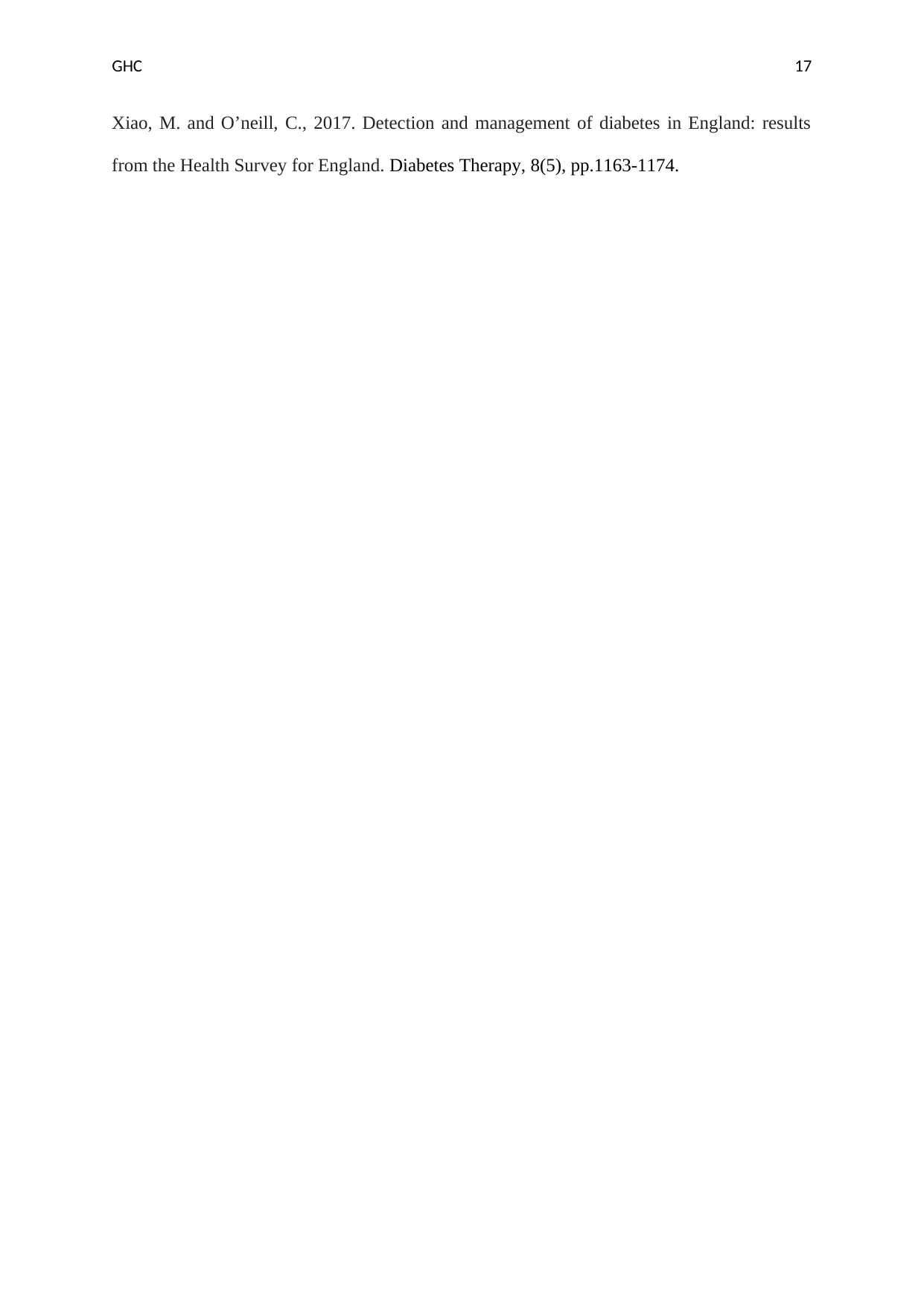
GHC 17
Xiao, M. and O’neill, C., 2017. Detection and management of diabetes in England: results
from the Health Survey for England. Diabetes Therapy, 8(5), pp.1163-1174.
Xiao, M. and O’neill, C., 2017. Detection and management of diabetes in England: results
from the Health Survey for England. Diabetes Therapy, 8(5), pp.1163-1174.
1 out of 18
Related Documents
Your All-in-One AI-Powered Toolkit for Academic Success.
+13062052269
info@desklib.com
Available 24*7 on WhatsApp / Email
![[object Object]](/_next/static/media/star-bottom.7253800d.svg)
Unlock your academic potential
© 2024 | Zucol Services PVT LTD | All rights reserved.





